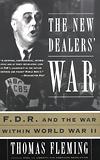THE
NEW DEALERS' WAR
 The
"Pearl Harbor" movie was a box-office flop, political
infighting over what form the World War II monument will
take has already begun; and, in a development that has
restored my faith in human nature, a recent wave of historical
revisionism, which exposes and debunks the mythology of
the "Good War," is cresting just as the festivities reach
their height. First came Robert Stinnett's Day
of Deceit: The Truth About FDR and Pearl Harbor.
The Stinnett volume shows that the President of the United
States not only knew when and where the Japanese attack
would take place, but also puts it in its proper context
as the logical outcome of a provocative policy aimed at
getting us into the European war through the Asian "back
door." Stinnett's not-too-narrow focus on this linchpin
event illuminates perfectly the policy of deceit that
preceded our entry into the war by throwing the spotlight
on the machinations behind the Pearl Harbor debacle. Now,
with the publication of Thomas Fleming's (not the editor
of Chronicles magazine) The
New Dealers' War: Franklin D. Roosevelt and The War Within
World War II (Basic Books, 2001), the entire landscape
of the wartime era is lit up bright as day.
The
"Pearl Harbor" movie was a box-office flop, political
infighting over what form the World War II monument will
take has already begun; and, in a development that has
restored my faith in human nature, a recent wave of historical
revisionism, which exposes and debunks the mythology of
the "Good War," is cresting just as the festivities reach
their height. First came Robert Stinnett's Day
of Deceit: The Truth About FDR and Pearl Harbor.
The Stinnett volume shows that the President of the United
States not only knew when and where the Japanese attack
would take place, but also puts it in its proper context
as the logical outcome of a provocative policy aimed at
getting us into the European war through the Asian "back
door." Stinnett's not-too-narrow focus on this linchpin
event illuminates perfectly the policy of deceit that
preceded our entry into the war by throwing the spotlight
on the machinations behind the Pearl Harbor debacle. Now,
with the publication of Thomas Fleming's (not the editor
of Chronicles magazine) The
New Dealers' War: Franklin D. Roosevelt and The War Within
World War II (Basic Books, 2001), the entire landscape
of the wartime era is lit up bright as day.
BRIGHT
AS DAY
The
real role of "that
man in the White House" as a power-mad, pro-Soviet,
warmongering Machiavellian, whose political instincts
and ideology were closer to that of his buddy "Uncle Joe"
Stalin than to any American politician, is here exposed
by Fleming, an acclaimed historian and novelist of note.
Before the Doris Kearns Goodwin Brigade goes into overdrive
smearing and castigating the author, let's take a look
at the book that deals a knockout punch to the myth of
the "Good War" and the cult of Saint Franklin.
MEMORY
AND HISTORY
Fleming
sets out his credo as a writer and historian in the Introduction,
where he recalls that in the vestibule of his family home
in the Jersey City of the 1940s, a portrait of Franklin
Delano Roosevelt hung on the wall "where many devout Irish-Catholic
families hung a portrait of the Sacred Heart of Jesus."
But this essentially religious feeling of loyalty and
hero-worship is "the stuff of novels, not history." The
purpose of historical fiction is to entertain, and, perhaps,
make a larger point about the meaning of the past and
the nature of human memory. The historian's task is the
exact opposite: it is "to separate history from memory"
and get at the truth. "In our understanding of the cataclysm
that historians call World War II, we are in the final
stage of celebrating the riches of memory," he writes.
"We are saluting the generation that won the titanic global
conflict. There is nothing wrong with this impulse. These
men and women deserve the literary and cinematic cheers
we are giving them." Ah yes, "but memory," he reminds
us, "is not history."
A
MYSTERY UNRAVELED
FDR's
present-day idolaters, the high priests of global interventionism
who burn incense at the altar of the "Good War" god, see
the past through the eyes of the present the politically
corrected present, that is but this, Fleming reminds
us, is the province of the novelist, not the historian.
In The New Dealers' War, Fleming gives us history
seen through the "eyes, the voices, the hearts and minds
of the men and women who lived through a particular time,
as they experienced it." I must say that, as a writer,
Fleming succeeds in bringing a sense of drama and immediacy
to his prose like no other historian I can recall. Reading
this book is like reading an expertly-consructed
mystery, as the author lets clue after clue lead the reader
to a final inescapable conclusion: that the "Good War"
wasn't so good after all.
THE
BIG SCOOP
On
December 4, 1941, the Chicago Tribune headline
was blazing with extraordinary news: FDR'S WAR PLANS!
The story detailed a heretofore secret document prepared
by the Army and Navy in which a ten-million man army would
be raised, half of which would invade Europe in 1943.
The Tribune reporter, Chesly Manly, even reprinted
the cover letter of the plan, a note from the President
authorizing its preparation. The public outcry was deafening.
This from the man who had vowed during his fight
for a third term that he would "never" send American troops
to fight in Europe!
SCORPIONS
IN A BOTTLE
You
have to remember, also, that (prior to Pearl Harbor) over
80 percent of the American people opposed America getting
into the war, and the anti-war America First movement
was holding rallies and battling the interventionists
on the floor of Congress. Roosevelt, meanwhile, was denying
that his actions and words were designed to get us into
war, and he reiterated his campaign pledge that the Yanks
were not coming. Disillusioned by the betrayal
of Versailles, and the debunking of the propaganda that
got us involved in World War I, Americans were inclined
to stay out of it this time: especially since the Russian
Reds and their socialist siblings, the German Nazis, had
turned on each other, like scorpions in a bottle, most
were content to let them fight it out and, hopefully,
destroy each other in the process. But back to "FDR"s
War Plans". . . .
A
WHODUNIT
Not
surprisingly, the man suspected of having leaked the super-secret
"Rainbow Five" plan, General Albert C. Wedemeyer, had
strong ties to America First and the anti-interventionist
faction of the military. The secretary of state declared
that the man who had leaked the document "had blood on
his hands," and the FBI questioned Wedemeyer, and his
family, getting him to admit that he attended America
First meetings (out of uniform) and investigating his
German-American family tree. But Wedemeyer, it turned
out, was innocent: they had nothing on him, and General
George C. Marshall stood up for him. Who, then, was the
leaker? The probable answer is sure to surprise (if not
shock) you.
BACK
DOOR TO WAR
Meanwhile,
the "back door" to war with Japan in the Pacific was widening.
Fleming details the series of provocations, punctuated
by American intransigence, that disregarded the desperate
last-minute efforts of the Japanese to reach a peaceful
settlement including the little-known Lanikai
incident, in which the President ordered the USS Lanikai,
a lightly-armed vessel off the Philippine coast, to set
sail for Indochina, held by the Japanese, where it would
be a sitting duck for Japanese warplanes. On December
8, however, the commander of the Lanikai received
a radio message telling him to come home. The war in the
Pacific was already in progress, and his mission was redundant.
AN
AWESOME PROBLEM
The
big problem was now how to accomplish the final aim of
FDR's war plan: provoking Germany into declaring war.
Since this was the one event that Hitler most dearly wished
to avoid, it was hard to see how this could be accomplished
but not if you were a master strategist (and completely
without any moral scruples) like Franklin Delano Roosevelt.
Faced with the prospect of war with Japan, but not with
Germany and Italy, the provocation he devised was incomparably
clever: he would leak the "Rainbow Five" plan to the isolationist
press and hope that Hitler would take his cue from there.
It worked. A few days after the Japanese attack on Pearl
Harbor, Germany declared war in the US, citing the Tribune
story as proof that FDR had been preparing for war
all along. As Fleming puts it:
"Pondering
this awesome problem [how to get Germany to declare war],
Franklin D. Roosevelt decided to capitalize on the one
huge advantage he had over his opponents, both at home
and abroad. He knew, thanks to the Purple intercepts,
that war with Japan was going to start in a few days,
a week at most. Why not leak Rainbow Five to one of the
antiwar leaders, who would undoubtedly leak it to one
of the antiwar newspapers, and inspire all these angry
people to fulminate against it in their most choleric
fashion? When Japanese aggression exploded in their faces,
they would be left speechless with embarrassment and
politically neutered. But that would be a minor triumph,
compared to the real purpose of the leak: to provoke Adolf
Hitler into a declaration of war."
IF
ONLY . . .
While
there is as yet no absolute proof that FDR was the leaker,
as Fleming admits, no other explanation fits the known
facts: Wedemeyer was exonerated by the military investigation,
and the claim by William Stephenson, the head of British
intelligence in the US, to have concocted the plan out
of whole cloth, is here debunked: "Rainbow Five" was undoubtedly
a real military plan, one worked on by Wedemeyer and others,
and its leakage was a major military blow to the US. Stephenson,
in his book A
Man Called Intrepid, furthermore claims that it
was he who provided FDR with the phony maps detailing
an alleged Nazi plan to invade America and this was
entirely made up out of whole cloth. Fleming asks: "Would
a president who had already used faked maps and concealed
from Congress the truth about the naval war in the North
Atlantic hesitate at one more deception?" Readers of Stinnett's
Day of Deceit will also ask: would a man who sacrificed
thousands of American lives and a good percentage of America's
Pacific fleet hesitate to sacrifice the national security
in hopes of achieving his longstanding goal of getting
into the European war? The official investigation "quit"
when it reached a certain point, as several military and
government figures involved later admitted, and Fleming
makes quite a convincing case as to why: after all, were
they supposed to arrest Roosevelt for treason? If only
they had. . . .
A
CHARACTER ISSUE
As
an introduction to the character of FDR who called himself
"the juggler" and insisted that, quite often, his right
hand did not know (or want to know) what his left hand
was doing this incident sets the scene for the rest
of the book, which is a devastating indictment of the
wartime President on every front. Fleming surveys the
New Deal, and sees it in much the same way as John T.
Flynn depicted it in his As
We Go Marching, an "American" variation of national
socialism or corporatism such as had arisen in Germany,
Italy, and Russia: "In a world where Russia had embraced
a form of state control called communism, and Germany
had opted for another variety of the same nostrum, national
socialism, while Italy embraced fascism, yet another variation
on authoritarian rule, the New Deal's attempt to insert
the government into American business on a broad and apparently
permanent scale, alarmed not a few people."
NINE
OLD MEN
This
echoes the analysis not only of Flynn, but also of other
Old Right critics of the New Deal such as Robert A. Taft
and Senator Burton K. Wheeler, who saw FDR as a would-be
American Caesar. The court-packing scheme, FDR's attempt
to bend the US Supreme Court "nine old men," he called
them to his will and overcome the last obstacle to his
assault on the hated "economic royalists," is seen by
Fleming as an act of hubris for which the President paid
dearly. The GOP said relatively little, while the Democrats
tore themselves apart in an internecine battle between
urban New Dealers and Midwestern progressives, who were
outraged at the President's bid to seize power. Conservative
Republicans and Midwestern progressives of both parties
came together in their opposition to FDR's brazen Caesarism,
and their analysis, given short shrift by liberal historians,
is here treated not only respectfully, but also seamlessly
integrated into Fleming's narrative as prescient and self-evidently
valid especially seen against the background of FDR
as a schemer and master manipulator.
WAR
AND THE NEW DEAL
His
"quarantine the aggressors" speech, given in 1937, had
not resulted in any great interventionist movement, and
Roosevelt had been forced to back away from his initial
stance on account of overwhelming antiwar sentiment. It
is "a terrible thing to look over your shoulder when you
are trying to lead and to find no one there," he confided
to one of his advisors. The American people did not want
to be led down the road to collectivism and war, they
were resisting it every step of the way. But the President's
pronounced sense of vainglory dictated that only he could
"lead a unified America into war with the Axis powers,
and rescue liberalism from domestic defeat," writes Fleming.
"These two ideas soon became closely interwoven in his
mind" and, I might add, closely interwoven in history.
A
NEW DEAL FOR THE WORLD
It
was, FDR believed, his moral duty to run for a third term.
To rescue the New Deal, which had failed to solve the
problem of unemployment, the second phase of the President's
political program was put into operation: "The New Deal
of War." War would achieve full production and damn
near full collectivization. In the phrase of Harry Hopkins,
the President's closest advisor, what the New Dealers
wanted was "a New Deal for the world" a worldwide leveling
redistribution of wealth, and a new "democratic world
order." The Westerm democracies, wrote Hopkins in a memo
to FDR, "must wage total war against totalitarian war.
It must exceed the Nazi in fury, ruthlessness, and efficiency."
Here, again, the Old Right critique of the New Deal as
the "War Deal" is echoed or implied in Fleming's narrative:
we would probably win the fight against national socialism
in the trenches, said Rose Wilder Lane at the time, only
to witness the triumph of national socialism on the home
front.
NOSTALGIA
FOR "UNITY"
The
attack on Pearl Harbor produced just what our scheming
President had long hoped for a nation united in its
hatred of the enemy, and one in which political dissent
could be crushed effortlessly. Not long after the attack,
the police arrested a young man in Chicago who had been
so indiscreet as to boo a newsreel shot of Roosevelt.
Edwin A. Loss, Jr. was fined $200 (a hefty fine at the
time) for disorderly conduct. This was the wartime zeitgeist
that our present-day intellectuals love to extol:
we were all "united" then, they say, and wasn't it wonderful?
The only proper response is: hell no! The GOP,
while issuing a statement of support for the President
and the war effort, also warned against the danger of
one-man or one-party rule. The GOP chairman declared that
the US must not become a carbon copy of the enemy it sought
to destroy: as Fleming writes, "it was the opening shot
of the war within the war" a war waged by Roosevelt
and his cronies against the Constitution, the American
system of free enterprise, and the fundamental liberties
that we were supposed to be fighting for.
THREE
THEMES
I
can only call attention to the highlights of this 500-page
historical opus, and perhaps a better strategy would be
to point out its three main themes: the "war within the
war," the criminal policy of demanding unconditional surrender
that resulted in discouraging and repudiating the German
resistance to Hitler, and FDR's strange willingness to
give the Soviets everything they wanted and more. Here
is the first major history of World War II that covers,
in any detail, the Great Sedition Trials of 1944, in which
the administration rounded up a potpourri of antiwar opponents,
branded them part of a worldwide Nazi conspiracy, and
held a mass trial involving over 50 defendants, all accused
of "sedition." It was the President who pressured his
attorney general, Francis Biddle, a liberal, to repeat
the repression of World War I, where antiwar radicals
had been rounded up and thrown in jail, and mob violence
had targeted German-Americans; against his better judgment,
Biddle went along, after initially resisting, and Fleming
shows how these trumped-up charges resulted in a farcical
trial that proved such an embarrassment to the administration
that it finally had to be dropped.
"ONCE
A JAP, ALWAYS A JAP!"
Then
there was the internment of Japanese-Americans, which,
as Fleming shows, was pushed by the most left-wing elements
of the New Deal coalition, in shameless alliance with
outright racists such as Rep. John Rankin of Alabama,
who, in claiming that Japanese were untrustworthy unto
the third generation, declared "Once a Jap, always a Jap.
You can't any more regenerate a Jap than you can reverse
the laws of nature." Even before Pearl Harbor, the leftist
daily newspaper PM, in New York, was calling for
the FBI to "crack down" in Hawaii, where many Japanese-Americans
lived. After Pearl Harbor was bombed, the beloved future
"Dr. Seuss," Theodore Geisel, drew
racist cartoons of slanty-eyed "Japs" lining up to
collect TNT at a house labeled "Honorable Fifth Column."
(Incredibly, as I was writing this review, I happened
to see an exhibition at the San Francisco Public Library
where an entire book of these racist cartoons is proudly
on display!) Another racist Geisel cartoon shows a sinister-looking
Japanese holding a spyglass: the piece was entitled "Waiting
for the Signal from Home." This appeared in PM
days before FDR issued the order consigning Japanese-Americans
to the internment camps.
THE
WAR WITHIN THE WAR
Another
aspect of "the war within the war" was the struggle between
the populist liberalism of the New Deal and the corporate
liberalism that made it possible to win the war. Fleming
depicts this as a battle between the New Dealers on the
left (such as Eleanor Roosevelt and Henry Wallace), and
FDR's corporate allies, who saw the war as a way to rationalize
their control of a command economy. "Eventually," writes
Fleming, "the New Dealers would make the dismaying discovery
that Franklin D. Roosevelt was no longer on their side
in the war within the war." What had started out as a
war against unrestrained capitalism became, in the end,
a war for liberal corporativism, or corporate capitalism.
This theme, taken up in 1972 by Murray N. Rothbard and
Ronald Radosh in their pathbreaking book, A
New History of Leviathan, is here illuminated
throughout the text, an analysis that ought to evoke considerable
understanding and sympathy from both sides of the political
spectrum.
UNCONDITIONAL
SURRENDER
The
most shameful and inexplicable of FDR's policies during
the war was the insistence on the unconditional surrender
of Germany. It was a policy fiercely opposed by the British,
by the Russians, and by nearly everyone but FDR and his
top advisors, who carried it out to the end with disastrous
results. The idea that the Germans had to be completely
destroyed, rather than merely defeated militarily; that
Germany was a special case that had to be treated with
special harshness; that German militarism and "Junkerism"
were somehow inherent in the German character and had
to be burned out of them over a long period of time, had
great appeal in the top echelons of FDR's administration,
and none more than the President himself. To FDR's everlasting
discredit, this policy led to the complete refusal of
the Allies to have anything to do with the heroic German
resistance to Hitler, which, early on in the war, took
root in the German high command. One would think that
"Dr. Win-the-War," as FDR liked to be called, would have
jumped on this opportunity to shorten the war, save millions
of lives, and bring down the German war machine. Unfortunately,
one would also be dead wrong. . . .
THE
UNKNOWN MARTYRS
It
is heartbreaking to read how the anti-Hitler faction in
the German military, including highranking officers such
as General Erwin Rommel, tried to negotiate with the President
to no avail. He would have nothing to do with them: indeed,
he issued statement after statement actively meant to
discourage and demoralize them, and when they were discovered
by the Gestapo and horribly murdered, the US and Great
Britain could only bring themselves to gloat, declaring
that this revolt by the "Junkers" was proof of Germany's
doom. Furthermore, the story of the German resistance
was subjected to military censorship: the order came from
the top that the American people were not to be told the
heroic story of these German martyrs who had given their
lives in the fight against Hitler. There are no
good Germans, was the policy and the point, and Americans
would not be allowed to discover otherwise. The policy
of unconditional surrender prolonged the war, and took
many millions of lives that would otherwise have been
spared and this, implies Fleming, is a war crime on
a par with that of the Nazis or the Soviet massacre at
Katyn
Forest. After reading this book, no one can deny it.
SEE
NO EVIL
Speaking
of Katyn Forest, the mass murder committed by the Soviets
in which thousands of Polish officers were slaughtered,
the reality of this was disbelieved by FDR and, when
it became undeniable, even to such a practiced evader
as the President, was actively covered-up by him. Not
only that, but FDR and his top associates took their instructions
from the Kremlin as to whom was to be purged from the
State Department: all the enemies of Russian communism
were either gotten rid of, at the Soviet Foreign Minister's
insistence, or else demoted to the nether reaches of the
diplomatic service until the war's end. As Walter Duranty
of the New York Times was detailing the glories
of living in the "workers paradise" of Soviet Russia (and
getting a Pulitzer Prize for it), millions were dying
of famine but the New Dealers would not hear a bad word
against their Communist allies. While the purge trials
were going on, and Stalin's political opponents (and millions
of ordinary non-political people) were being sent to the
gulag, the attitude of the American ambassador, Joseph
C. Davies, is succinctly summed up by Fleming as "see
no evil, hear no evil, think no evil about Russia."
AMONG
FRIENDS
We
know, today, that many
of FDR's inner circle Harry Dexter White, Laughlin Currie,
and others were Soviet agents, but even in this
context it is hard to explain the consistently pro-Soviet
attitude of the President of the United States, especially
at his meetings with Stalin at Yalta and Teheran. Here
FDR is shown in his absolutely worst light, denigrating
Winston Churchill to win Stalin's approval, and sucking
up to the Soviets so shamelessly as to be almost beyond
belief. In a conversation with Stalin at Teheran, one
from which Churchill was deliberately excluded, FDR remarks
that what was needed in India was "reform from the bottom,
somewhat on the Soviet line." When Stalin averred that
India was a "complicated problem," and that such a "reform"
would indeed have to mean a revolution, Fleming informs
us that "Roosevelt dismissed this observation with a toss
of his head, as if to say 'What's a Bolshevik upheaval
or two among friends?'"
THE
"GOOD WAR"
World
War II is herein described as "the New Dealers' war" because
they wanted it, they started it, and they profited from
it. It was a war that produced, at home, a Welfare-Warfare
State that so bloated and transformed the federal government
that our old Republic was no longer recognizable: abroad,
it resulted in the triumph of Communism in Eastern Europe
and China the conquest of practically a third of the
earth's surface. It was a war that gave birth to a new
world war, a "cold war" that constantly threatened to
turn hot, and one that also wiped out the last remnants
of resistance to our policy of internationalism, which
deemed that the US must from this day hence become an
empire. It was the beginning of the American Century,
that celebration of global hegemony first enunciated by
Time magazine publisher Henry Luce and now celebrated,
60 years later, by the left and the right in pious unison.
World War II is called the "Good War" but whom
was it "good" for?
"GOOD"
FOR WHOM?
It
was good for the New Dealers, who wanted to set up their
own version of collectivism in America, and dreamed (as
Harry Hopkins put it) of a "New Deal for the world." It
was good for Joe Stalin, who conquered not only Eastern
Europe but China and secured for him a direct line to
the US government, with hundreds of agents planted
in the top echelons in Washington. It was good for the
corporate liberals, and the corporatist businessmen, who
profited from the war both materially and politically.
It was good for the Democratic party, which smeared its
Republican antiwar rivals as agents of Hitler and came
very close to establishing a wartime dictatorship in this
country. It was good for internationalist Republicans
like Wendell Wilkie the John McCain of his time (see
p. 348 especially, and marvel at the remarkable parallels)
who emasculated the GOP's opposition to the Welfare-Warfare
State, and turned Republicans into the party of me-tooers
(a legacy that bedevils them to this day).
REVISIONIST
RENAISSANCE
World
War II was, in short, not just a military struggle between
the Allies and the Axis powers, but a war within a war
a political war of the new managerial America against
the old America of the Founding Fathers. But the victory
of the former over the latter, while definite, was not
definitive: that this book has been written, and published,
is proof that the battle continues, not only in the realm
of domestic politics and international affairs, but also
in the realm of history and of ideas. That is the war
being fought today, a battle started by the revisionist
historians of the postwar era, such as Harry Elmer Barnes,
Charles A. Beard, Charles Callan Tansill, and others,
and carried on by Fleming and Stinnett. FDR got away,
for the most part, with his schemes to drag us into the
European maelstrom and snare us into collectivism but
the battle for historical truth is not lost. Far from
it, that struggle has just begun and a great victory
has been won with the publication of The New Dealers'
War, which is truly a high point in the renaissance
of World War II historical revisionism. Buy this book,
read it, and pass it on to your friends and then get
ready for the establishment's hysterical reaction, for
it will not be long in coming. . . . .
AN
ANNIVERSARY 300 COLUMNS!







